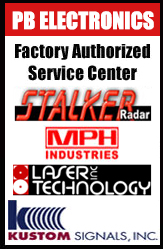The Texas Department of Public Safety produced a
comprehensive manual based on the Federal tests.
It cautions operators, "...the radar does not
generate 'false' readings. Anytime a reading
appears, the radar has sensed a signal. The
radar operator must be familiar with situations
that can produce 'error' readings." If the
operator does not detect the error, a ticket
will be wrongfully issued.
Here are the radar "errors" detailed by the
Texas manual:
1. Antenna Positioning Error
The radar beam travels in a straight line,
neither bending around curves nor following the
contour of hilly terrain. If the antenna is not
properly positioned, it may seem to clock an
approaching car when, in fact, it's clocking
another car in the background.
2. Look-Past Error
Even if the operator aims his antenna properly,
radar is still subject to "look-past" error.
This is caused by the radar looking past a small
reflection in the foreground to read a larger
reflection behind. This error is all the more
insidious because poorly-trained operators
assume it can't happen.
Texas instructors warn, "It is a widely-held
misconception that the reflected target signal
received by the radar antenna will always be
that of the closest vehicle to the antenna.
There are times, due to traffic conditions, that
the closest vehicle is not returning the
strongest signal."
Evidence of the potential size of this error
appeared in Car and Driver (October, 1979). The
author measured the effective range of a Kustom
Signals KR11 traffic radar against various
vehicles. The typical small sedan did not show
up on the radar until it was less than 1200 feet
away from the antenna, but the same radar unit
locked on to a Ford 9000 semi at 7600 feet. This
shows how common vehicles reflect microwaves
differently.
The Texas instructors confirm this problem
with radar, saying "It is not unfair to say that
the reading you register could be a larger,
better target three-quarters of a mile down the
road."
3. Vehicle Interference Error
"Vehicle interference" error occurs when
moving radar is used in traffic. For example,
traffic ahead can confuse the radar's estimate
of patrol speed. Moving radar calculates target
speed by subtracting patrol speed from the
closing speed of the target. Therefore, anything
that produces a low evaluation of patrol speed
will automatically result in a high speed
reading of target speed.
Texas tells its radar operators that this
"...situation becomes more critical if
difference in patrol speed and
interference-vehicle speed is five to ten mph. A
target vehicle moving 61 mph may be recorded at
66-71. These borderline speeds are more
difficult to detect with the eye."
4. Cosine Error
Cosine error produces a result similar to
Interference error except no moving traffic need
be present. A stationary object adjacent to the
road, such as a building, or road machinery, or
even a sign, makes a more efficient reflector
than horizontal pavement. Therefore the radar
uses that reflection as the basis of patrol
speed.
If this reflector were positioned straight
ahead on a collision path, the patrol speed
estimate would be close enough. But the further
the object is located off a direct line to the
target, the lower will be the estimate of patrol
speed. This is a simple trigonometry problem
relating to the cosine of the angle between the
target and the ground reflector, hence the name
Cosine error. Since Cosine error always makes
patrol speed seem smaller than it actually is,
it always acts to raise the reading of target
speed.
5. Double-Bounce Error
Microwaves are easily reflected. That's what
makes radar possible. But the operator must be
aware of the difference between an ordinary
reflection and a bad bounce. Big objects such as
trucks are very efficient reflectors, and it's
possible for the radar beam to bounce off
several moving trucks at once, always producing
erroneous readings.
6. Beam-Reflection error
Because microwaves are so readily reflected,
Texas instructors recommend caution, even in
mounting the antenna within the patrol car. They
say it's possible that a reflective path can be
set up through the rearview mirror that will
produce radar readings on vehicles behind the
patrol car when the radar is aimed forward. And
those vehicles behind can be either coming or
going, since radar does not distinguish
directions.
7. Road-sign error
The ready reflectability of microwaves means
that road signs are also source of errors.
8. Radio-Interference Error
According to the Texas course, "UHF radio now in
use can force radar to read various numbers when
you transmit, or just key the mike. Citizens
band radio transmissions from within the patrol
vehicle can cause ghosting (false readings)." It
recommends that no radio transmissions be made
while clocking target vehicles.
9. Fan-Interference error
When the antenna is mounted inside the patrol
car, the Texas course says, "Radar will have a
tendency to read the pulse of the fan motor (air
conditioner, heater, or defroster)." The
instructors go on to say, however, that the fan
reading will disappear when a target comes into
range, and that the fan will not distort the
speed reading of the target car.
However, in the case of moving radar, they
say, "Sometimes a steady fan speed will override
patrol car speed reflected from the roadway."
When this happens, the false speed reading
produced by the fan will be substituted for
patrol speed in the moving radar's calculation
of target speed. Since the calculation consists
of subtracting patrol speed from closing speed,
if the fan reading is less than patrol speed,
then the speed displayed for the target will be
incorrectly high.





